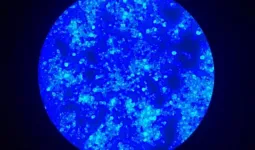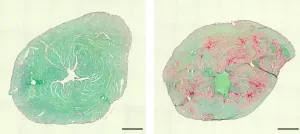(Press-News.org) The concentration of potentially toxic metals is increasing in the population of the franciscana dolphin --a small cetacean, endemic from the Rio de la Plata and an endangered species-- according to a study led by a team of the Faculty of Biology and the Biodiversity Research Institute (IRBio), published in the journal Science of The Total Environment.
The impact of human activity in the region could be the cause for the increase of trace elements such as chromium, copper, iron and nickel in the dolphins' biological tissues, as stated in the study. The paper counts on the participation of members from the National History Museum of Uruguay, and is subsidized through a project of the research and conservation program of the Barcelona Zoo Foundation, with Massimiliano Drago (UB-IRBio) as principal researcher.
One of the smallest and most threatened dolphin species worldwide
The franciscana dolphin (Pontoporia blainvillei) is an endemic species of the marine regions of Brazil, Uruguay and Argentina, and it is considered a vulnerable species according to the International Union for the Conservation of Nature (IUCN). Currently, it is considered the most threatened cetacean in the southwestern Atlantic Ocean, and its population decreased due to accidental bycatches that accelerated by mid-20th century with the artisanal shark fishing to take vitamin A. Now, the future of this species is in danger due to accidental fishing --it causes between 1200 and 1800 dolphin deaths every year, mainly juvenile ones-- and the progressive degradation of the environment due to the impact of maritime transport, tourism and environmental pollution.
Rio de la Plata: biological productivity and anthropogenic pollution
The Rio de la Plata estuary, in the western coast of the southwestern Atlantic Ocean, is one of the richest and most productive ecosystems worldwide. It is an affected marine region by the anthropogenic activity (maritime transport, industry, expansion of urban areas, untreated wastewaters, etc.) which favours the accumulation of pollutants. Also, the estuary receives the transported pollutants by the water network of the river branches of the Parana and Uruguay rivers and other secondary rivers. With more than three million kilometres of expansion, this large water system transports a great volume of water masses that are highly polluted during their passing for big towns and urbanized regions in the South American continent.
In the internal area of the estuary --the most polluted one-- there is a lot of freshwater from river branches and the waste from nearby cities (Buenos Aires, Montevideo, la Plata, etc.). The area in the middle has freshwater with marine influence and is less polluted while the external area has salty waters with a salinity gradient. There are marine currents, generated by the regime of tides in the estuary, that drive the entrance of the marine water in the intermediate area and the exit of freshwater towards the external section.
Analysis of trace elements on dolphin bone remains
The pollutants such as polychlorinated biphenyl, pesticides, hydrocarbons, plasticizers, or some metals can be endocrine or cancer disruptors, and they can cause adverse reproductive effects or osteoporosis, among others. Among the pollutants that are thrown into the estuary "are trace elements, which are specially worrying, such as certain heavy metals that can be highly toxic for the marine fauna and indirectly, for humans", notes Odei García-Garín, first author of the article and member of the Research Group on Large Marine Vertebrates, led by Professor Àlex Aguilar.
The paper analyses the concentration of trace elements in franciscana dolphin bone remains in Rio de la Plata during the 1953-2015 period. According to the results, the concentration of chromium, copper, iron and nickel, has increased in sixty-two years, while the levels of lead have been reduced in the dolphin bone remains.
Anthropogenic activities could be the origin of the growing concentration of metals in marine mammals, as stated in the study. The trace elements coming from the waste of the industries of leather, petroleum refineries and painting from boats would accumulated progressively in the sediments of the Rio de la Plata estuary and eventually, in the tissue of the franciscana dolphins. Contrary to this, the prohibition from the nineties to use lead as additive in fossil fuel involved the progressive reduction of the concentration of this metal in the dolphins' bones.
The study also points out to a temporary increase in the concentrations of aluminium and manganese, and parallelly, a decrease in the concentrations of arsenic and strontium. These temporary tendencies are hard to relate to the anthropogenic pollution and will require more studies to reach conclusions. The results indicate a higher concentration of aluminium, iron and chromium in females, although the differences are not significant.
The paper published in Science of the Total Environment confirms the suitability of the trace element studies on bone remains conserved in museums or private collections to conduct large-scale temporary studies. Using this methodology, we can analyse both the impact of pollutants on a species in temporary series and the evolution of compounds in the environment.
Protecting the franciscana dolphin for the conservation of the marine environment
The franciscana dolphin is an apical marine predator and plays an essential role in the marine ecosystem. It shapes the abundance of several species --fish, octopuses, prawns, etc.-- that hold a medium trophic level in the ocean. Therefore, if the population of Franciscan dolphins decreases, it would completely alter the whole trophic marine network in the estuary. "In addition, the franciscana dolphins act as an 'umbrella' species. That is, protecting their populations would benefit many other species whose viability depends on the presence of the franciscana dolphin in the marine ecosystem", notes Odei García-Garín, member of the Department of Evolutionary Biology, Ecology and Environmental Sciences and IRBio.
"In order to improve the survival of the species, we need to reduce the accidental fishing as the first urgent measure", continues García-Garín. "Since juvenile individuals are the most affected ones, it would be important to implement ban periods during the breeding seasons, the most critical ones for the species. Promoting fish farms would help reduce the accidental fishing, although this measure could bring other negative effects for the marine environment (eutrophication and contamination by the waste produced by fish farms, etc.). "It would be convenient to create or expand marine reserves where the species live and reduce the contamination produced by large cities and industries --improvement of wastewater treatment systems and rivers that run into the sea, --also key strategies to improve the conservation of this vulnerable mammal", concludes the researcher.
INFORMATION:
LAWRENCE -- The United States has the highest population of incarcerated citizens among developed nations. Every year, roughly 2 million women, the majority held in jails, leave incarceration. The COVID-19 pandemic hit jails and correctional facilities harder than almost any other societal setting. Many of the people leaving incarceration are returning to communities that were also disproportionately affected by the pandemic, yet many people in that population have expressed hesitancy to receive a COVID-19 vaccine.
New research from the University of Kansas found high rates of vaccine hesitancy among women transitioning from incarceration, due to a multitude ...
Syracuse, N.Y. - A study of nearly 550 adults with intellectual and developmental disabilities receiving residential services in New York City found that age, larger residential settings, Down syndrome and chronic kidney disease were the most common risk factors for COVID-19 diagnosis, and heart disease was most associated with COVID-19 deaths.
The study, "Risk Factors Associated With COVID-19 Outcomes Among People With Intellectual and Developmental Disabilities Receiving Residential Services," was published June 8 by JAMA Network Open and provided the first evidence of the risk factors leading to COVID-19 diagnosis and death among people with IDD who receive residential services.
The study's findings suggest that ...
Fully occupied intensive care units (ICUs). Physically and mentally exhausted health workers. Chaotically overcrowded hospitals. These and similar problems posed by the COVID-19 pandemic in Brazil have created ideal conditions for the emergence of Candida auris, a microorganism some are calling a "superfungus" because of the speed with which it has developed drug resistance.
The first two cases were confirmed in December 2020 at a hospital in Salvador (state of Bahia, Northeast Brazil), and are described in the Journal of Fungi by a group of researchers led by Arnaldo Colombo, head of the Special Mycology Laboratory at the Federal University of São Paulo (UNIFESP). The study was supported by São Paulo Research Foundation - FAPESP.
"Nine other C. auris patients ...
TROY, N.Y. -- The future of quantum computing may depend on the further development and understanding of semiconductor materials known as transition metal dichalcogenides (TMDCs). These atomically thin materials develop unique and useful electrical, mechanical, and optical properties when they are manipulated by pressure, light, or temperature.
In research published today in Nature Communications, engineers from Rensselaer Polytechnic Institute demonstrated how, when the TMDC materials they make are stacked in a particular geometry, the interaction that occurs between particles gives researchers more control over the devices' properties. Specifically, the interaction between ...
A discovery from researchers at the University of Illinois Chicago may lead to new treatments for individuals who suffer from alcohol use disorder and depression.
The study, "Transcriptomics identifies STAT3 as a key regulator of hippocampal gene expression and anhedonia during withdrawal from chronic alcohol exposure," is published in the journal Translational Psychiatry by researchers at UIC's Center for Alcohol Research in Epigenetics.
"During withdrawal from long-term alcohol use, people often suffer from depression, which may cause them to start drinking again as a way to self-medicate. If we ...
The spin of the Milky Way's galactic bar, which is made up of billions of clustered stars, has slowed by about a quarter since its formation, according to a new study by researchers at University College London (UCL) and the University of Oxford.
For 30 years, astrophysicists have predicted such a slowdown, but this is the first time it has been measured.
The researchers say it gives a new type of insight into the nature of dark matter, which acts like a counterweight slowing the spin.
In the study, published in the Monthly Notices of the Royal Astronomical Society, researchers analysed Gaia space telescope observations of a large group of stars, the Hercules stream, which are in resonance with the bar - that is, they revolve around the galaxy ...
An international team of researchers led by the University of Bonn (Germany) has identified the cause of a rare, severe muscle disease. According to these findings, a single spontaneously occurring mutation results in the muscle cells no longer being able to correctly break down defective proteins. As a result, the cells perish. The condition causes severe heart failure in children, accompanied by skeletal and respiratory muscle damage. Those affected rarely live beyond the age of 20. The study also highlights experimental approaches for potential treatment. Whether this hope will be fulfilled, however, will only become clear in a few years. The results are published in the journal Nature ...
A funny thing happened on the way to discovering how zinc impacts kidney stones - two different theories emerged, each contradicting the other. One: Zinc stops the growth of the calcium oxalate crystals that make up the stones; and two: It alters the surfaces of crystals which encourages further growth. Now it can be told - both theories are correct as reported in the America Chemical Society journal Crystal Growth & Design by Jeffrey Rimer, Abraham E. Dukler Professor of Chemical and Biomolecular Engineering at the University of Houston, who conducted the first study to offer some resolution to the differing hypotheses.
"What we see with zinc is something ...
Our ability to confront global crises, from pandemics to climate change, depends on how we interact and share information.
Social media and other forms of communication technology restructure these interactions in ways that have consequences. Unfortunately, we have little insight into whether these changes will bring about a healthy, sustainable and equitable world. As a result, researchers now say that the study of collective behavior must rise to a "crisis discipline," just like medicine, conservation and climate science have done, according to a new paper published June 14 in the Proceedings of the National Academy of ...
(Santa Barbara, Calif.) -- Scientists at UC Santa Barbara, University of Southern California (USC), and the biotechnology company Regenerative Patch Technologies LLC (RPT) have reported new methodology for preservation of RPT's stem cell-based therapy for age-related macular degeneration (AMD).
The new research, recently published in Scientific Reports, optimizes the conditions to cryopreserve, or freeze, an implant consisting of a single layer of ocular cells generated from human embryonic stem cells supported by a flexible scaffold about 3x6 mm in size. ...




